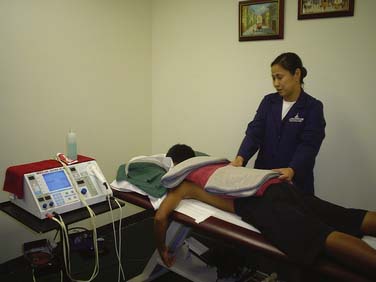44 Thermal Applications
Physiologic Effects of Local Application of Heat
Heat energy applied to a localized area of the body produces changes not only at the site of application, but also in surrounding tissues and in distant regions. The resultant changes counter the threat to thermal equilibrium and assist the local structures to avoid tissue damage. The local effects are caused by the elevated temperature response of cellular function by direct and reflex action. The rise in temperature is accompanied by an increase in blood flow. Dilatation of the capillaries on exposure to local heat leads to an elevation of hydrostatic pressure and an increase in capillary permeability. The increase in permeability leads to an increase in leukocytic and antibody infiltration in the area, which is an important factor in controlling inflammation and promoting early healing. However, an increase in hydrostatic pressure may cause edema of the desired region. This effect would contraindicate the use of heat in conditions where swelling or edema is to be avoided.1
Superficial heat remodels connective tissue by three mechanisms. First, heat creates several physiologic changes through subsequent vascular changes, causing vasodilation. This dilation gives an analgesic effect, which increases the patient’s pain threshold and results in greater tolerance of connective tissue stretching. Second, physiologic effect of heat is an alteration of the viscous flow properties of collagen, which results in the relief of joint stiffness. Third, there is an increase in the extensibility of collagen tissue, a major component of connective tissue, through changes in its viscoelastic properties following the application of heat.2
In general, the transfer of heat (whether the purpose is heating or cooling) often is classified into four general types of heat transfer: conduction (hot pack, paraffin bath), convection (fluidotherapy, hydrotherapy), conversion (radiant heat), and radiation. The most commonly used in clinical application is conduction, through the agency of water.1 The level of the tissue temperature (usually 40 to 45° C), duration of the tissue temperature increase, rate of increase in the tissue temperature, and the size of the area being treated determine the extent of the physiologic response to heat.
Commonly Used Heat Modalities in Present Clinical Setting
Hot Packs or Hydrocollator Packs
To prevent burning, adequate layer(s) of towel should be added during the duration of treatment and the patient should never lie on the packs because the patient’s body weight could squeeze hot water out of the pack into the towel and potentially cause a burn. It is highly recommended to check the patient every 5 minutes. Indications for the application of hot packs may include painful muscle spasms, abdominal muscle cramping, menstrual cramps, and superficial thrombophlebitis.3
Contraindications may include peripheral vascular diseases, skin eruptions at the site of application, desensitized skin, new skin, and obtunded sensorium of the patient.4
Determine the wrapping procedure to be used. Apply the hot pack to the area to be treated. Cover it with a dry towel. Check the patient every 5 minutes (Figs. 44-1 to 44-3).











